September 28, 1978
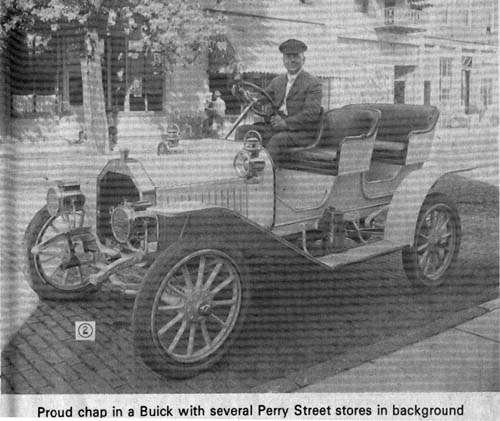
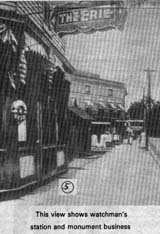
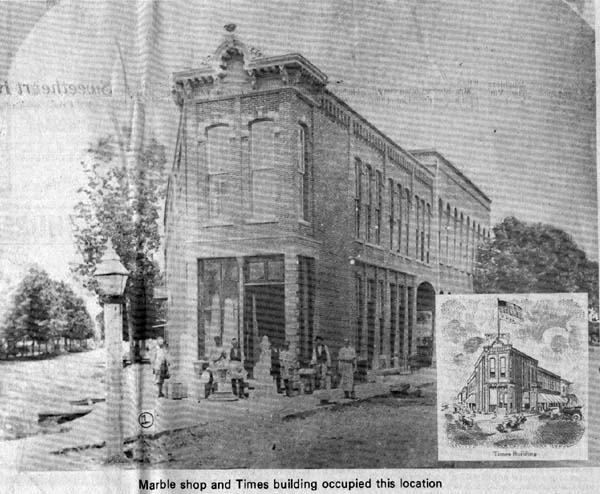
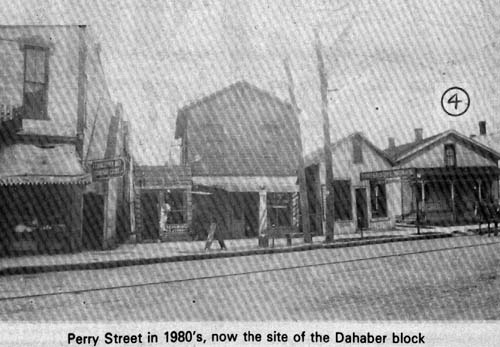
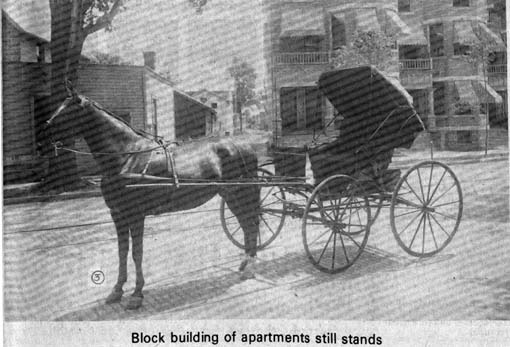
Picture #1 – Proud chap in a Buick with several Perry Street stores in background
Picture #2 – This view shows watchman’s station and monument business
Picture #3 – Marble shop and Times building occupied this location
Picture #4 – Perry Street 1880’s, now the site of the Dahaber block
Picture #5 – Block building of apartment still stands
Time changes lots of things…sometimes for the good and sometimes quite the contrary. As a rule, the effects of change can’t be seen until years later and then its too late.
The readers of this column will have to decide for themselves if the changes mentioned in today’s story that have taken place have been beneficial or detrimental.
Today’s column is the first in a series of reviews of what Perry Street looked like many years ago…to some readers a nostalgic look backwards to some periods in their life when they were growing up in Fostoria. To the younger generation, or to newcomers to Fostoria, the comparison of the accompanying old photos with today’s scenes may be startling.
TIMES SQUARE
Let’s start our backward look at the corners of Main, Perry and Sandusky streets…once called Times Square, because The Fostoria Times, one of two newspapers in Fostoria years ago, occupied the building that was located where Standard Oil filing station is now.
Prior to occupancy by The Times, (insert photo), the building housed the W.D. Robbins Marble Shop, as can be seen by the photo. Called a marble shop, they made grave markers, but I presume they probably also made marble table tops for the antique furniture, so much sought after today, and perhaps marble window sills.
The businesses that were in the buildings on Main Street side is another story for later.
When The Times was purchased by The Review, that was the start of the transformation of Times Square corner. The Times building, owned by Roscoe Carle, publisher, was sold and eventually demolished, to become a site for successive filing stations.
Photo No 2 shows another view of Perry Street. The Times building is in the right of the photo, and included that portion to the room with the circus posters in the window. The building in the left of the photo had residential living quarters on the second floor and business room downstairs. Two of the businesses I remember were Weber Cigar and Restaurant. In later years Bloom build and operated a restaruant on Findlay Road where the Putt and Pond is now.
The chap in the Buick looks proud as punch to be photographed.
Now, lets look at photo #3. Yes, it’s the same building that is there now. Rowan Apartments, but then it was McDonel Apartments. Oh, my…a slick horse and buggy, which were still commonplace then. Notice the streetcar tracks (Toledo, Fostoria and Findlay) and the street paved with bricks.
In the left of the photo, in the background, can be seen the cement block house that still stands there. Peter Gardner and wife resided there for many years. In the front of the house is a frame building, no longer there which was where Gardner had a barber shop.
Prior to H.L. Porter establishing his Dye Works, he had a pawn shop in a frame building that was located on the Perry Street side of the land where McDonald’s Gulf is now. In later years, the building was moved to Sandusky Street, near Fremont.
PORTER LAND MARK
Let’s cross to the other side of Perry Street. There have been changes there too. In the extreme right of photo No. $ can be seen a house where the H.L. Porter family lived…yes the same Porter family that started the Dye Works and Dry Cleaning business in 1889 in the frame building to the left of their residence. Porter’s business stayed in the family and in the same place for 74 years, until it was purchased by Charles Lyburtus, a long-time employee at Porters. He continued to operate the business until recently when it was purchased by Richard Baker of Findlay. He will continue in the same place and under the same name.
When photo #4 was taken, the 2-story frame building to the left of Porters housed a barber shop, where haircuts cost 15 cents and shaves 10 cents.
The small one-story structure to the left was a shoe repair shop, probably run by Earl French (see list below)
The two-story structure with the outside entrance for upstairs housed a second hand store on the first floor, probably run by Joseph Henning (see list below). The Dehaber building stands there now.
UNUSUAL VIEW
Photo #5 shows an unusual view, which I have never seen before, owned by Bill Wonders. In the extreme left is a frame building standing where the brick structure now is, which burned out almost two years ago.
The watchman’s shanty for the LE & W railroad can be seen in the photo. Then in the right of the photo can be seen a portion of the Poley Building, as it was known then, now the Dehaber Building.
Joseph Poley built the building and had a monument business there for many years. There’s a lot of interesting history connected with the Poley place which warrants a separate story, later. Monuments can be seen in the photo. Poley was a colorful and well known Fostorian.
The frame building where Maggie’s Sub Station now is, is the same one where I.W. Dicken had his photographic studio for many years, and which Bill Wonders Studio occupied until 1970 when they moved to their present location.
The west side of Perry Street from Maggies on to Fremont hasn’t changed much within my memory.
I.W. Dicken lived at 127 in the house still there. Bill Daub’s parents lived at 133 in the same house. Dwight Young’s family lived at 143 in the same house there now. Craft Croner…at another period in time that house was also a furniture store, owned and operated by Emil and Lucille Kimball.
DI CESARE HOUSE REDON
The Di Cesare family lived for many years in the frame dwelling at Perry and Fremont across from the Presbyterian church, but sold a year or more ago. That building has been completely remodeled for business occupants.
There were many business conducted on Perry Street from Times Square, north toward Fremont Street throughout past years. It is impossible to remember or to list all of them that came and went, but here is a partial list, including some from a city directory for the years 1909-10, with addresses:
Poley Marble Works – 101
Fostoria Times – 102
H.E. Kohn-Dry Goods, Notions Shoes, Ladies Furnishings, Furs – 103-105
Joseph Henning – Second Hand Store – 107
LeRoy Earl Painting Contractor – 107 1/2
Geo. M. Fink – Electrical Supplies – 110
Roy Johnson – barber – 111
Porter’s Dye Works – 113
Fostoria Furnace Company – 112
Ohio and Western Lime Co – 116
I.W. Dicken Photographic Studio – 121
Peter Gardner – barber – 144
Next week we will continue north on Perry Street and discover the other dramatic changes that have taken place on one of Fostoria’s important and busy streets.